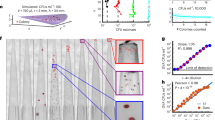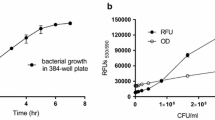Abstract
Cryptococcus neoformans causes an estimated 600,000 AIDS-related deaths annually that occur primarily in resource-limited countries. Fluconazole and amphotericin B are currently available for the treatment of cryptococcal-related infections. However, fluconazole has limited clinical efficacy and amphotericin B requires intravenous infusion and is associated with high renal toxicity. Therefore, there is an unmet need for a new orally administrable anti-cryptococcal drug. We have developed a high-throughput screening assay for the measurement of C. neoformans viability in 1,536-well plate format. The signal-to-basal ratio of the ATP content assay was 21.9 fold with a coefficient of variation and Z' factor of 7.1 % and 0.76, respectively. A pilot screen of 1,280 known compounds against the wild-type C. neoformans (strain H99) led to the identification of four active compounds including niclosamide, malonoben, 6-bromoindirubin-3′-oxime, and 5-[(4-ethylphenyl)methylene]-2-thioxo-4-thiazolidinone. These compounds were further tested against nine clinical isolates of C. neoformans, and their fungicidal activities were confirmed. The results demonstrate that this miniaturized C. neoformans assay is advantageous for the high-throughput screening of large compound collections to identify lead compounds for new anti-cryptococcal drug development.





Similar content being viewed by others
References
Park BJ, Wannemuehler KA, Marston BJ, Govender N, Pappas PG, Chiller TM (2009) Estimation of the current global burden of cryptococcal meningitis among persons living with HIV/AIDS. AIDS 23(4):525–530
Bicanic T, Meintjes G, Wood R, Hayes M, Rebe K, Bekker LG, Harrison T (2007) Fungal burden, early fungicidal activity, and outcome in cryptococcal meningitis in antiretroviral-naive or antiretroviral-experienced patients treated with amphotericin B or fluconazole. Clin Infect Dis 45(1):76–80
Rabjohns JLA, Park YD, Dehdashti J, Zheng W, Williamson PR (2013) A high throughput screening assay for fungicidal compounds against Cryptococcus neoformans. J Biomol Screen (in press)
Chen CZ, Kulakova L, Southall N, Marugan JJ, Galkin A, Austin CP, Herzberg O, Zheng W (2011) High-throughput Giardia lamblia viability assay using bioluminescent ATP content measurements. Antimicrob Agents Chemother 55(2):667–675
Cho SH, Warit S, Wan B, Hwang CH, Pauli GF, Franzblau SG (2007) Low-oxygen-recovery assay for high-throughput screening of compounds against nonreplicating Mycobacterium tuberculosis. Antimicrob Agents Chemother 51(4):1380–1385
Coconnier-Polter MH, Lievin-Le Moal V, Servin AL (2005) A Lactobacillus acidophilus strain of human gastrointestinal microbiota origin elicits killing of enterovirulent Salmonella enterica Serovar Typhimurium by triggering lethal bacterial membrane damage. Appl Environ Microbiol 71(10):6115–6120
Hu G, Hacham M, Waterman SR, Panepinto J, Shin S, Liu X, Gibbons J, Valyi-Nagy T, Obara K, Jaffe HA, Ohsumi Y, Williamson PR (2008) PI3K signaling of autophagy is required for starvation tolerance and virulence of Cryptococcus neoformans. J Clin Invest 118(3):1186–1197
Kim K, Pollard JM, Norris AJ, McDonald JT, Sun Y, Micewicz E, Pettijohn K, Damoiseaux R, Iwamoto KS, Sayre JW, Price BD, Gatti RA, McBride WH (2009) High-throughput screening identifies two classes of antibiotics as radioprotectors: tetracyclines and fluoroquinolones. Clin Cancer Res 15(23):7238–7245
Xu M, Liu K, Southall N, Marugan JJ, Remaley AT, Zheng W (2012) A high-throughput sphingomyelinase assay using natural substrate. Anal Bioanal Chem 404(2):407–414
Wang Y, Jadhav A, Southal N, Huang R, Nguyen DT (2010) A grid algorithm for high throughput fitting of dose–response curve data. Curr Chem Genomics 4:57–66
Jarvis JN, Harrison TS (2007) HIV-associated cryptococcal meningitis. AIDS 21(16):2119–2129
Lewis JS 2nd, Graybill JR (2008) Fungicidal versus fungistatic: what’s in a word? Expert Opin Pharmacother 9(6):927–935
Saag MS, Powderly WG, Cloud GA, Robinson P, Grieco MH, Sharkey PK, Thompson SE, Sugar AM, Tuazon CU, Fisher JF et al (1992) Comparison of amphotericin B with fluconazole in the treatment of acute AIDS-associated cryptococcal meningitis. The NIAID Mycoses Study Group and the AIDS Clinical Trials Group. N Engl J Med 326(2):83–89
Pfaller MA, Castanheira M, Diekema DJ, Messer SA, Jones RN (2011) Wild-type MIC distributions and epidemiologic cutoff values for fluconazole, posaconazole, and voriconazole when testing Cryptococcus neoformans as determined by the CLSI broth microdilution method. Diagn Microbiol Infect Dis 71(3):252–259
Diamond RD, Bennett JE (1974) Prognostic factors in cryptococcal meningitis. A study in 111 cases. Ann Intern Med 80(2):176–181
Cho MH, Niles A, Huang R, Inglese J, Austin CP, Riss T, Xia M (2008) A bioluminescent cytotoxicity assay for assessment of membrane integrity using a proteolytic biomarker. Toxicol In Vitro 22(4):1099–1106
Weinbach EC, Garbus J (1969) Mechanism of action of reagents that uncouple oxidative phosphorylation. Nature 221(5185):1016–1018
Tseng AS, Engel FB, Keating MT (2006) The GSK-3 inhibitor BIO promotes proliferation in mammalian cardiomyocytes. Chem Biol 13(9):957–963
Huang MJ, Cheng YC, Liu CR, Lin S, Liu HE (2006) A small-molecule c-Myc inhibitor, 10058-F4, induces cell-cycle arrest, apoptosis, and myeloid differentiation of human acute myeloid leukemia. Exp Hematol 34(11):1480–1489
Butts A, Didone L, Koselny K, Baxter BK, Chabrier-Rosello Y, Wellington M, Krysan DJ (2013) A repurposing approach identifies off-patent drugs with fungicidal cryptococcal activity, a common structural chemotype, and pharmacological properties relevant to the treatment of cryptococcosis. Eukaryot Cell 12(2):278–287
Acknowledgments
This work was supported by the Intramural Research Programs of the Therapeutics for Rare and Neglected Diseases, National Center for Advancing Translational Sciences (NCATS), and National Institute of Allergy and Infectious Diseases, National Institutes of Health (NIH). The authors thank Paul Shinn and compound management team at NCATS for their assistance.
Author information
Authors and Affiliations
Corresponding authors
Rights and permissions
About this article
Cite this article
Dehdashti, S.J., Abbott, J., Nguyen, DT. et al. A high-throughput screening assay for assessing the viability of Cryptococcus neoformans under nutrient starvation conditions. Anal Bioanal Chem 405, 6823–6829 (2013). https://doi.org/10.1007/s00216-013-7134-4
Received:
Revised:
Accepted:
Published:
Issue Date:
DOI: https://doi.org/10.1007/s00216-013-7134-4




